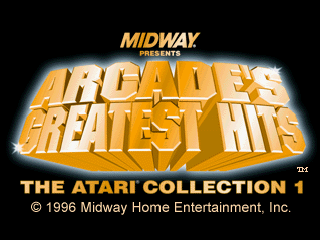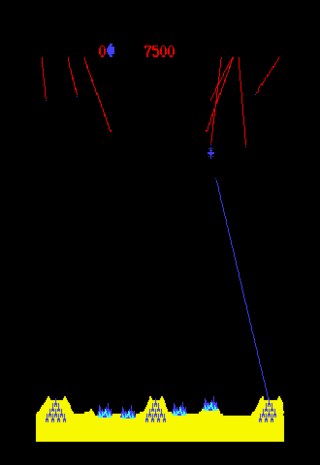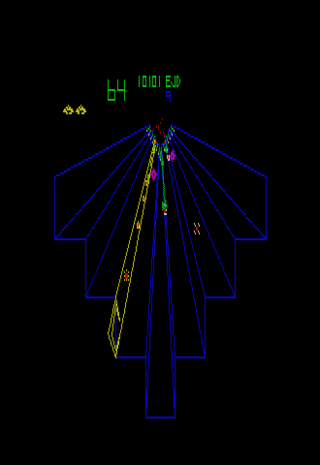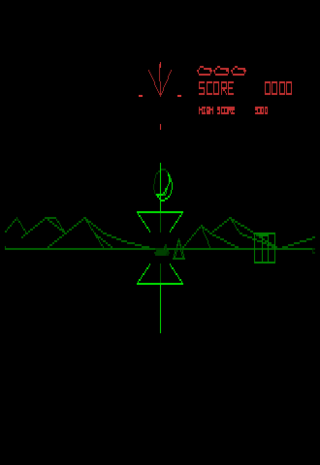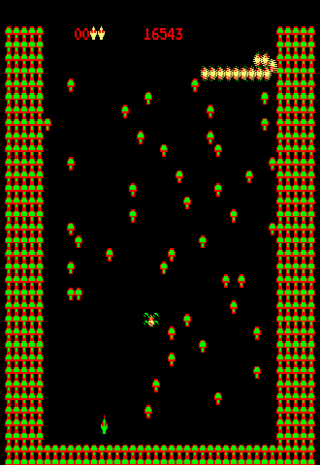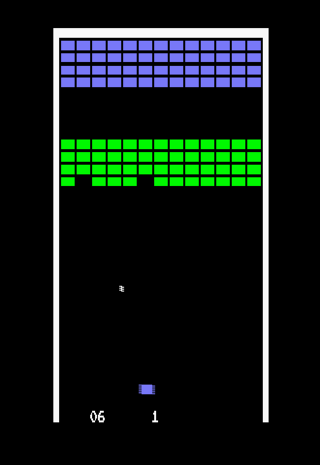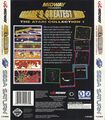Midway Presents Arcade's Greatest Hits: The Atari Collection 1
From Sega Retro
| Midway Presents Arcade's Greatest Hits: The Atari Collection 1 | |||||||||||||||||||||||||||||||||||
|---|---|---|---|---|---|---|---|---|---|---|---|---|---|---|---|---|---|---|---|---|---|---|---|---|---|---|---|---|---|---|---|---|---|---|---|
| System(s): Sega Saturn | |||||||||||||||||||||||||||||||||||
| Publisher: Midway Home Entertainment (US), GT Interactive Software (Europe) | |||||||||||||||||||||||||||||||||||
| Developer: Digital Eclipse | |||||||||||||||||||||||||||||||||||
| Licensor: Atari Corporation | |||||||||||||||||||||||||||||||||||
| Original system(s): Arcade boards | |||||||||||||||||||||||||||||||||||
| Developer(s) of original games: Atari, Inc. | |||||||||||||||||||||||||||||||||||
| Game total: 6 | |||||||||||||||||||||||||||||||||||
| Peripherals supported: Mission Stick, Saturn Backup Memory, Saturn Floppy Drive, Shuttle Mouse | |||||||||||||||||||||||||||||||||||
| Genre: Compilation | |||||||||||||||||||||||||||||||||||
| Number of players: 1-2 | |||||||||||||||||||||||||||||||||||
| |||||||||||||||||||||||||||||||||||
|
Midway Presents Arcade's Greatest Hits: The Atari Collection 1 is a compilation of various classic arcade games created by Atari, Inc. It was brought to the Sega Saturn by Digital Eclipse and Midway Games.
Contents
Gameplay
From the game select menu, pressing ![]() loads the selected game, pressing
loads the selected game, pressing ![]() opens its extras, and pressing
opens its extras, and pressing ![]() opens its options. The game includes multiple videos about the history of Atari and about every game except Super Breakout.
opens its options. The game includes multiple videos about the history of Atari and about every game except Super Breakout.
After loading a game, pressing START at any point raises a menu allowing the players to exit back to the main menu, reset the emulator, switch to another game without returning to the menu, or save the high scores to the Saturn's internal memory.
The game has analog controls in Centipede, Missile Command, and Super Breakout when played with a Mission Stick. This analog mode does not work on the 3D Control Pad.
History
Even though this compilation was produced by Midway, who owned Atari Games at this point, the games were licensed from Atari Corporation which retained ownership of Atari, Inc.'s games after it had split into two companies in 1984. This was one of the few times the two Ataris associated with each other.
Production credits
- Developed by Digital Eclipse Software, Inc.
- Programming: Dan Filner
- Executive Producer: Andrew Ayre
- Arcade Hardware Gurus: Jeff Vavasour, Tod Frye
- Game Sound Processing: Doug Jefferys, John Kowalski, Dave Larson
- Cinematics and Animation: Midnight Design
- History and Video Interviews: Chris Charla
- Additional Artwork: Image Impressions, Sue Ayre
- Video Editing: Flying Rhino Productions
- Audio Editing: Earwax Productions
- History Narration: Sandy Mahoney
- Archivist: Sean Kelly
- Extra Special Thanks: Ed Logg, Dave Theurer, Ed Rotberg, George and Peter Phillips, Sue Urbanski, John Delaplaine, Boyd Burggrabe, Larry DeMar, Mike Albaugh, Keith Feinstein, Gregg Woodcock, David Borlo
- Vice President of Development: Bill Hindorff
- Produced by: Wallace Poulter
- Testing Manager: Mike Kruse
- Atari Games Testing Leads: Jesse Meza II, Jose Amparan, Randy Slafsky
- Atari Games Testers: Todd Papy, David Ortiz, Donald Gavino, Kevin Dines, Pablo Buitrago, Matt Gilbert, C.J. Perez, Rob Reininger, Joseph Magome
- Special Thanks to: Debra Heinz, Debbie Austin, Deborah Fulton, Ed Logg, Greg Allen, Brian Fritts
- Game Design and Programming: Ed Logg
- Game Design Contribution: Lyle Rains
- Engineer: Howie Delamn
- Technician: Paul Manucso
- Game Design and Programming: Ed Rotberg
- Project Leader: Morgan Hoff
- Hardware Engineer: Jed Margolin
- Technician: Doug Snyder
- Game Design and Programming: Ed Logg, Donna Bailey
- Game Design Contribution: Dan Van Elderen
- Technician: Dave Wiebenson
- Game Designer and Lead Programmer: Dave Theurer
- Assistant Programmer: Rich Adam
- Project Leader: Steve Calfee
- Hardware Engineer: Dave Sherman
- Technician: Mary Pepper
- Programming: Ed Logg
- Original Concept: Owen Rubin, Nolan Bushnell
- Technician: Steve Ehret
- Game Designer and Programmer: Dave Theurer
- Project Leader: Morgan Hoff
- Hardware Engineer: Sam Lee
- Technician: Doug Snyder
- Mathbox Microcode: Jed Margolin
- Midway is a registered trademark of Williams Electronics Games, Inc.
- Arcade's Greatest Hits is a trademark of Midway Home Entertainment, Inc.
- Asteroids Copyright © 1979, 1996, Battlezone Copyright © 1980, 1996, Centipede Copyright © 1980, 1996, Missile Command Copyright ©1980, 1996, Super Breakout Copyright © 1978, 1996, Tempest Copyright © 1980, 1996 Atari Games Inc. All rights reserved. Used under license.
- Digital Arcade (tm) Emulation Software Copyright 1996 Digital Eclipse Software Inc.
- Digital Eclipse and the Digital Eclipse Logo are trademarks of Digital Eclipse Software, Inc.
- Andrew Ayre: Andrew served as Executive Producer of Arcade's Greatest Hits™: The Atari Collection 1 and is President of Digital Eclipse Software.
- Dan Fliner: Dan was the Lead Programmer on Arcade's Greatest Hits™: The Atari Collection 1. When Dan isn't programming, he's usually on inline skates!
- Doug Jefferys, John Kowalski & Dave Larson: These gentlemen were responsible for reproducing the original game sounds.
- Chris Charla: Chris conducted the interviews in the game history.
- Flying Rhino Productions: Flying Rhino Productions provided digital post-production on the video interviews.
- Earwax Productions: Earwax Productions provided production on the narrative.
- Sandy Mahoney: Narrator
- Midnight Design: Midnight Design provided original computer-generated animation.
- Sue Ayre & Image Impressions: Provided additional still artwork.
- V.P. of Product Development: Bill Hindorff
- Producer: Wallace Poulter
- Testing Manager: Mike Kruse
- Lead Testers: Jose Amparan, Jesse Meza I & Shubrian Butler
- Testers: Todd Papy, David Ortiz, Randy Slafsky, Alex Beran, Matt Gilbert, Pablo Buitrago, C.J. Perez, Donald Gavino, Kevin Dines & Rob Reininger
- Special Thanks: Howard Lehr, Debra Heinz, Greg Allen, Brian Fritts and Finn Jensen - Manager of the Scandia Family Center in Suisun, Ca.
- Special Thanks to the Original Atari Team Members: Ed Rotberg, Ed Logg & Dave Theurer
- Print Design and Production: Debra Austin, Jon Mongelluzzo, Shawn Murphy, Robert Shepherd, Erin Shems & Dave Young
- Special Thanks: Deborah Fulton, Don Knapp & Bruce Adams
Magazine articles
Physical scans
| Sega Retro Average | |||||||||||||||||||||||||||||
|---|---|---|---|---|---|---|---|---|---|---|---|---|---|---|---|---|---|---|---|---|---|---|---|---|---|---|---|---|---|
|
| 62 | |
|---|---|
| Based on 5 reviews | |
Technical information
External links
- Sega of America webpage: Saturn
References
- ↑ http://riehlspot.simplenet.com/vgame/new/saturn.html (Wayback Machine: 1999-02-21 17:22)
- ↑ Computer & Video Games, "March 1998" (UK; 1998-02-11), page 45
- ↑ Computer Trade Weekly, "" (UK; 1998-06-29), page 20
- ↑ http://centromail.es:80/nuevo/consolas/sat.asp (Wayback Machine: 1998-04-30 18:14)
- ↑ File:Midway Presents Arcade's Greatest Hits The Atari Collection 1 Saturn credits.pdf
- ↑ File:AGHACV1 sat us manual.pdf, page 18
- ↑ Game Informer, "October 1997" (US; 1997-xx-xx), page 66
- ↑ MAN!AC, "07/98" (DE; 1998-06-03), page 73
- ↑ Sega Magazin, "September 1998" (DE; 1998-08-05), page 15
- ↑ Sega Saturn Magazine, "May 1998" (UK; 1998-04-15), page 62
- ↑ Video Games, "6/98" (DE; 1998-05-27), page 98
| Midway Presents Arcade's Greatest Hits: The Atari Collection 1 | |
|---|---|
|
Main page | Comparisons | Development | Magazine articles | Reception | Technical information | |
| Midway, Williams and Atari compilations for Sega systems | |
|---|---|
| Arcade Smash Hits (1992) | |
| Arcade Classics (1996) | Williams Arcade's Greatest Hits (1996) | |
| Arcade Classics (1996) | |
| Midway Presents Arcade's Greatest Hits (1996) | Midway Presents Arcade's Greatest Hits: The Atari Collection 1 (1997) | |
| Midway's Greatest Arcade Hits Volume 1 (2000) | Midway's Greatest Arcade Hits Volume 2 (2000) | Atari Anniversary Edition (2001) | Midway's Greatest Arcade Hits Volume 3 (unreleased) | |
- Saturn Backup Memory-compatible games
- Mission Stick-compatible games
- Shuttle Mouse-compatible games
- 1-2 player games
- US Saturn games
- All US games
- EU Saturn games
- All EU games
- DE Saturn games
- All DE games
- ES Saturn games
- All ES games
- UK Saturn games
- All UK games
- PL Saturn games
- All PL games
- Saturn games
- 1997 Saturn games
- All 1997 games
- Saturn game compilations
- All game compilations
- Saturn games with Cinepak video
- All games
- Midway Presents Arcade's Greatest Hits: The Atari Collection 1
